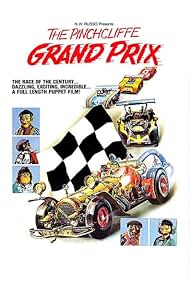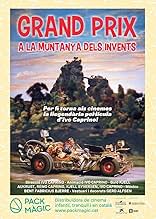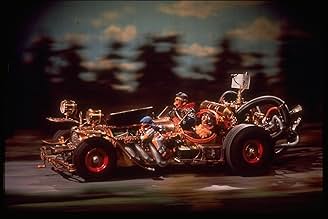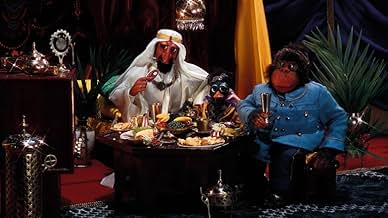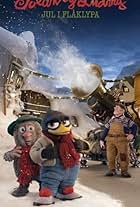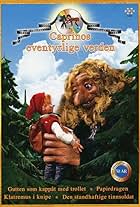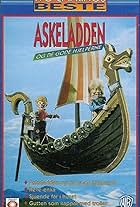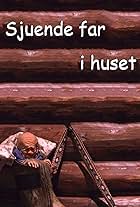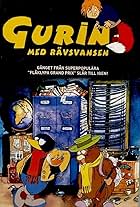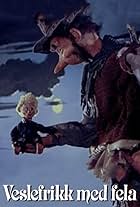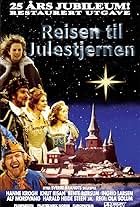IMDb RATING
8.4/10
15K
YOUR RATING
Reodor Felgen decides that he will enter a car race to defeat his former friend who has stolen his plans for a car.Reodor Felgen decides that he will enter a car race to defeat his former friend who has stolen his plans for a car.Reodor Felgen decides that he will enter a car race to defeat his former friend who has stolen his plans for a car.
Leif Juster
- Narrator
- (voice)
Henki Kolstad
- Speaker
- (voice)
Toralv Maurstad
- Ludvig
- (voice)
Frank Robert
- Reodor Felgen
- (voice)
Kari Simonsen
- Solan
- (voice)
Storyline
Did you know
- TriviaSince its premiere on 28 August 1975, the movie was shown at a cinema somewhere in the world every day of the week, for 28 years. Mainly in theaters in Norway, Moscow or Tokyo, the non-stop run ended in 2003.
- GoofsShadow from camera is visible during the car race.
- Alternate versions1995 re-issue has digitally reconstructed soundtrack and soundmix.
- ConnectionsEdited into Dra meg baklengs inn i fuglekassa (1976)
Featured review
To many Norwegians, this is perhaps one of the most important movie the country has ever produced. Even those who refuse to acknowledge Norwegian film industry tend to have a soft spot for this movie. I am Norwegian myself, and I have grown up with this - so obviously this review will be a bit biased. But I firmly believe it would not have gotten its place in Norwegian culture, had it not been for it being such a high quality movie - in all respects.
The story is simple, but great fun. Reodor (en: Theodore) is an inventor that lives in a small village (Flåklypa/Pinchcliffe) with his two animal companions. Solan (en: Sonny) is an overly optimistic magpie, while Ludvig (en: Lambert) is an overly pessimistic hedgehog. Reodor discovers that an man who used to work for him has stolen the design of a car component, and used it to become a racing champ. Reodor (kind of) decides to make his own car, and it all ends in a race. This over-arching storyline is not so important though, as it is only a device used to show of the characters, the settings, the moods, the dialog, and the beautiful naive spirit of the movie. As a Norwegian, it's easy to point at it and say that he captures the Norwegian spirit - but I'm sure most countries has the same curiosity, the same strange characters and the same way of looking at life.
As a fan of animation, the stop motion work in this movie is at times incredible. Especially in some of the scenes in Reodor's garage, and during the unveiling of the car. The amount of work that would have had to be put into creating all that movement must have been astounding. There's also other small touches that are very nice. When ever a character is jumping, it's so seamless that you don't think about the amount of work being put into it looking natural. Now, all of this said, there are also some sequences where the animation is clunky. The use of back projection is obvious in many scenes (especially in the HD version), and you can also tell at times that they are using smaller models than in the rest of the film. All in all, it's a great piece of craft.
The other highlight of the movie is the music. The Danish composer Fabricius Bjerre has managed to make tunes that sound so Norwegian that many assume that they were old folk tunes. You'll find yourself whistling some of the themes long after the movie is over.
One part of the movie that has not aged so well, is the Arab oil sheik. He is an obvious caricature, based on stereotypes. In today's political climate, you could not have a character like him. That said, it's never a mean spirited caricature, and throughout the film, it feels more they are poking fun at him as royalty, not as an immigrant or anything like that. It's definitely "kicking upwards".
And a last aside: I was fortunate enough to be able to see this with some non-Norwegians who were not that acquainted with the movie, and they pointed out a fun detail that I had never thought of: the narrator gives the post man as long an introduction as the main characters. My friend was surprised by this, as the postman is barely in the movie at all. For some reason, to me, it's always just made sense for the narrator to introduce the post man - because he just happens to be there the morning the narrator decides to talk about the gang.
The story is simple, but great fun. Reodor (en: Theodore) is an inventor that lives in a small village (Flåklypa/Pinchcliffe) with his two animal companions. Solan (en: Sonny) is an overly optimistic magpie, while Ludvig (en: Lambert) is an overly pessimistic hedgehog. Reodor discovers that an man who used to work for him has stolen the design of a car component, and used it to become a racing champ. Reodor (kind of) decides to make his own car, and it all ends in a race. This over-arching storyline is not so important though, as it is only a device used to show of the characters, the settings, the moods, the dialog, and the beautiful naive spirit of the movie. As a Norwegian, it's easy to point at it and say that he captures the Norwegian spirit - but I'm sure most countries has the same curiosity, the same strange characters and the same way of looking at life.
As a fan of animation, the stop motion work in this movie is at times incredible. Especially in some of the scenes in Reodor's garage, and during the unveiling of the car. The amount of work that would have had to be put into creating all that movement must have been astounding. There's also other small touches that are very nice. When ever a character is jumping, it's so seamless that you don't think about the amount of work being put into it looking natural. Now, all of this said, there are also some sequences where the animation is clunky. The use of back projection is obvious in many scenes (especially in the HD version), and you can also tell at times that they are using smaller models than in the rest of the film. All in all, it's a great piece of craft.
The other highlight of the movie is the music. The Danish composer Fabricius Bjerre has managed to make tunes that sound so Norwegian that many assume that they were old folk tunes. You'll find yourself whistling some of the themes long after the movie is over.
One part of the movie that has not aged so well, is the Arab oil sheik. He is an obvious caricature, based on stereotypes. In today's political climate, you could not have a character like him. That said, it's never a mean spirited caricature, and throughout the film, it feels more they are poking fun at him as royalty, not as an immigrant or anything like that. It's definitely "kicking upwards".
And a last aside: I was fortunate enough to be able to see this with some non-Norwegians who were not that acquainted with the movie, and they pointed out a fun detail that I had never thought of: the narrator gives the post man as long an introduction as the main characters. My friend was surprised by this, as the postman is barely in the movie at all. For some reason, to me, it's always just made sense for the narrator to introduce the post man - because he just happens to be there the morning the narrator decides to talk about the gang.
- How long is The Pinchcliffe Grand Prix?Powered by Alexa
Details
- Release date
- Country of origin
- Language
- Also known as
- Hintertupfinger Grand Prix
- Production company
- See more company credits at IMDbPro
Contribute to this page
Suggest an edit or add missing content

Top Gap
By what name was The Pinchcliffe Grand Prix (1975) officially released in India in English?
Answer